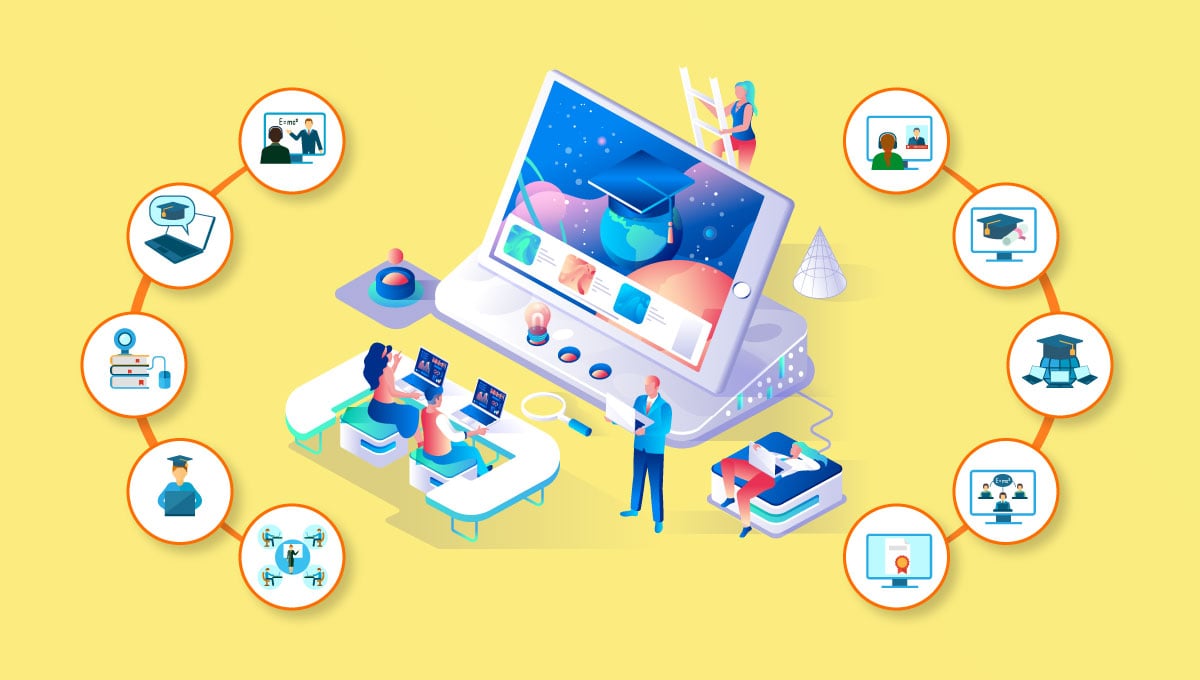
When you are considering learning methods and approaches to develop employees’ skills, it might seem at first like counting stars in the night sky—there are so many possibilities.
But before you reach this point, you’d have explored the staffing implications of your organization’s goals.
This initial phase of consideration is essential. It’s when you take a deep look at your firm’s future business performance targets and goals and clarify the workforce skills you’ll need to get you there.
You need to do an inventory of your employees’ current skills, analyze skills gaps, and identify candidates for upskilling or reskilling.
Many factors will affect the learning approach you take.
- Your company culture,
- the skills needed and training required,
- the budget,
- your access to learning technologies and platforms, and
- the interests, needs, and aptitudes of the people you are trying to educate, train, upskill, or reskill.
All too often, line managers unilaterally decide on learner needs and approaches. But often, the first best practice for creating an effective L&D program is to decentralize the learning process.
Find out what your people want to learn and how they’d like to learn it, then harness that to company needs. Most times, the demand for learning comes directly from the employees themselves.
- Do your people want a blended learning approach with a mix of in-person and online training?
- Would they prefer bite-sized, interactive learning modules they can access whenever they want on their mobile phones?
- Do they have specific external credentials in mind?
- Or might some prefer a mentorship or coaching experience to learn on-the-job skills and competencies in a more nurturing, one-to-one relationship?
Figuring this out early on will help your L&D team develop and deliver learning and training materials and projects in the best format for your people.
Types of learning methods
Ways to define learning methods sometimes overlap. But as the UK’s professional body for HR, the CIPD, does, you may categorize learning methods like this:
- Formal or informal techniques
- Internal or external providers
- Team or individual approaches
- Digital or face-to-face delivery
- Created or curated resources
- Formal course or a series of accessible resources on a topic
- Learning in the flow of work or away from the workplace.
Here are ten learning methods to consider, in no particular order.
1. Formal training programs
These may be face-to-face, online via an LMS, or use mixed delivery modes. Some programs may lead to certification to meet government or industry compliance regulations.
HIPAA (Health Insurance Portability and Accountability Act of 1996) compliance training is an example from the healthcare industry. One provider, for instance, is EdApp, which delivers the training conveniently on its mobile LMS platform. Nurses, doctors, and anyone who comes into contact with protected health information must have HIPAA training.
Stepping away from compliance programs, organizations offer access to thousands of other learning and training options.
Consider, for instance, how the food service chain Chipotle Mexican Grill and the global power generation firm Siemens each help their employees learn in unique ways, as shared in the informative HRE article by Phil Albinus on How Upskilling and Learning Can Help Neutralize the Great Resignation.
2. Employer-sponsored continuing education
Employers can provide financial and other support to employees pursuing programs leading to a credential, degree, or certificate.
One example (from many others) is Google Career Certificates in data analytics, digital marketing, e-commerce, IT support, project management, and user experience design. While still working at their regular jobs, employees can gain a certificate in three to six months of part-time study and be ready to transition into new roles with minimum business disruption.
The Association for Talent Development (ATD) offers a detailed report on best practices for employer-sponsored education.
3. Informal, personalized, on-demand learning
These can happen on LXP or LMS platforms, or through multimedia channels, including social media.
They are forms of voluntary self-learning often made appealing and relevant to people through consumer-grade multimedia elements such as good quality video demos, gamification elements, or social and collaborative opportunities for shared learning and informal chat forums about the learning.
If your organization helps employees plot career paths, you can easily align them with personalized training approaches.
Learners can personalize learning paths using AI features that track their interests and flag relevant courses and opportunities, like a Netflix approach to content. If your organization has already achieved digital transformation, you can use AI and machine learning for content suggestions.
Personalized learning involves four core elements: targeted instruction, data-driven decisions, flexible content, and student reflection and ownership. Training managers need to have well-curated content options.
Examples of on-demand self-directed learning include short online LinkedIn Learning or YouTube how-to videos on many business-related subjects you can start and stop at any time.
4. Mentorship and coaching experiences
Organizational studies show that a strong coaching culture correlates with high-performing organizations. Employees prefer coaches to bosses and respond better to coaching and mentorship to learn new skills.
Coaching and mentoring are development approaches that use one-to-one conversations to enhance an individual’s skills, knowledge, or work performance. Mentoring arrangements last for a more extended period than coaching arrangements.
Modern mentoring may use technologies to match existing mentors with incoming mentees, tailored according to career objectives, communication styles, and organizational roles and aspirations. Some programs may even go remote so relationships can continue, regardless of geography.
5. On-the-job learning
This includes self-training (often mobile compatible); orientation programs; co-worker training; job shadowing; internships; job rotations; and special project or committee assignments.On-the-job learning is a broad category that may embrace several other categories listed in this blog: apprenticeships, coaching experiences, and talent marketplace short projects.
6. Apprenticeships
Hands-on learning is often the best kind for individuals learning a specialized trade or craft, such as training to become an electrician, a cook, an artisan, or even a computer technician.
Ali Bokhari of Accenture Federal Services noted in March 2022 that apprenticeships are expanding in the US, with over 636,000 apprentices registered with the Department of Labor. He gives some good advice to firms considering launching an apprenticeship program in his March 2022 HRE article: “3 Best Practices for Launching an Apprenticeship Program.”
There are many excellent examples of apprenticeship training, including tech apprenticeship programs for IT jobs which are increasingly hard to fill. In the US, registered apprenticeships in computer and mathematical occupations have shot up from 369 in 2015 to 2,684 in 2021, according to an Urban Institute document. Still, it’s an under-used training method in the US compared to European countries with more robust apprenticeship systems.
7. Internal gigs via your talent marketplace.
The flexibility of gig work appeals to employees who want to experiment and stretch their capabilities in new directions without quitting their jobs. The popularity of talent marketplaces is evidence of this.
Gloat, the pioneer in talent marketplace software, offers exciting case studies on its website. One is Schneider Electric, which used Gloat’s Talent Marketplace to save $15 million in enhanced productivity and reduced recruiting expenses.
8. Recognition programs.
Recognition programs of different kinds can reward and motivate learning and help build a more caring, positive company culture. The best programs create a good emotional connection with employees, making them feel valued for each educational or training objective they achieve.
Some firms may even offer better compensation or perks for valued team members who have shown improved performance after their L&D experience.
9. Be part of a learning culture—from top to bottom.
A corporate culture that encourages ongoing learning can work wonders for motivation, employee experience, and learning progress. But it takes time and the right business leadership mindset to develop.
HR can find many imaginative ways to boost active learning. It can encourage employees to carve out time every day to learn something. It can offer bonus points, thoughtful prizes, or meaningful awards for learning achievements. And it can show that learning is a core company value, from the CEO to the newest intern.
A culture of learning can create a strategic advantage, too, as Forbes Business Council member Andrew Rahaman shared in a recent Forbes article.
10. Review, get feedback, and revise your learning methods
Whichever methods, platforms, or tools you use, timely two-way feedback between employees and L&D professionals is a powerful tool to boost employee learning.
For instance, if learners struggle with a learning app or understanding a piece of content, you can address that in real time. Find out why learners are dropping out. Perhaps you need to change the format, the learning method, the content, or all three.
Feedback informs managers about issues, unforeseen problems, or methods that need changing or adjusting. It also helps remove assumptions about the best approach to learning and recognizes that today, people learn in many ways.
Feedback can be obtained through direct conversations or anonymous surveys.
Learning analytics tools can provide another form of data-driven feedback on learner behavior and metrics and help you assess the effectiveness of your L&D initiatives and methods.
What learning methods will work best for your organization?
PhenomᵉCloud is a comprehensive technology solutions provider committed to empowering businesses to overcome challenges, enhance their workforce capabilities, and achieve superior outcomes.


Leave a Comment